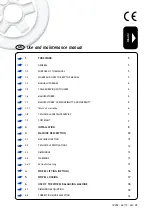
21
Balancer Cube
Operator’s manual
5. Keep the Distance/Diameter sensor blocked at this distance, then, rotate it until the adhesive weight
sticks on the rim. The sensor’s contact point on the rim will assume an intermediate position between
12 o’clock and 6 o’clock depending on the diameter of the rim. See also table T3.3;
6. Bring the Distance/Diameter sensor back in the rest position. The indications on the left and right
display will be exchanged to indicate the search for the external balancing plane;
7. Release the wheel and repeat steps 2 to 6 for the external weight;
8. Run a balancing test launch.
If the balancing of an identical wheel must be performed, you can skip the balancing plane acquisition
phase and carry on directly with the balancing launch and, subsequently, with the search of the balancing
planes. The balancing planes used for calculation will be those previously stored.
Note:
I
f you set the Static imbalance display, the sole balancing weight must always be applied in the 6 o’clock
posi-tion at any point along the section of the rim. The balancing planes search phase described in chapter
3.3.5.1 should therefore not be run.
3.3.6 Use of the ALS1 or ALS2 Program Types without automatic acquisition
When a machine is not equipped with the automatic acquisition system by means of the Distance/Diameter
sensor, or when the sensor itself has been disabled, you can still use the special ALS1 or ALS2 programs.
Since it is not possible to acquire the two planes automatically by means of the Distance/Diameter sensor,
you must manually enter the values of the two pairs of dimensions
di1/da1
and
di2/da2
as shown in
chapter 3.3.2
Manual entering of the wheel dimensions for the ALS1, ALS2 Program Types
.
After the
start
, the angular position of the balancing weights are given in table T3.3.
Table T3.3 Angular position of the balancing weights in the ALS1 and ALS2 Program Types with-
out automatic acquisition system
Program Type
Internal Plane
External Plane
Static Plane
ALS1
H12
H6
H6
ALS2
H6
H6
H6
3.3.7 Use of the ALS1 or ALS2 Program Types without preliminary acquisition
of the balancing planes
It is possible to run a launch when any Program Type, other than ALS1 or ALS2, is enabled and then
selecting the ALS1 or ALS2 Program Type. The machine will recalculate the imbalance data according to
the new Program Type selected.
In this case, however, the imbalance values displayed are obtained by using the balancing planes (i.e. the two
di1/da1
and
di2/da2
) dimension pairs previously acquired or, lacking these, the default balancing planes.
Summary of Contents for OSPREY BP63
Page 1: ...BP63 OSPREY...

































